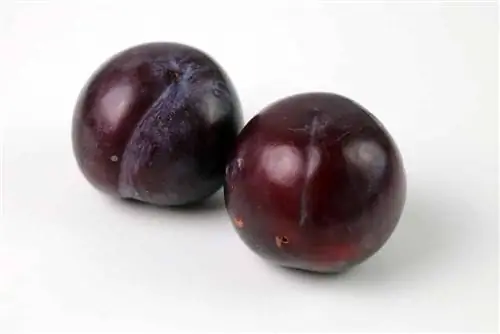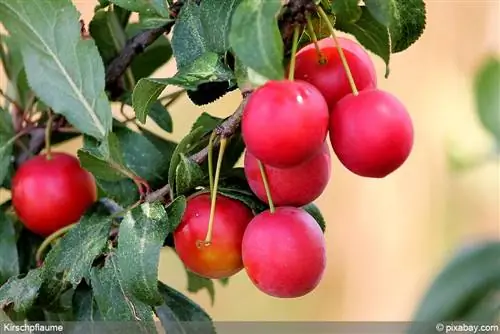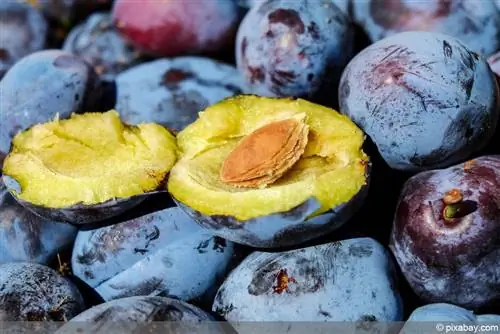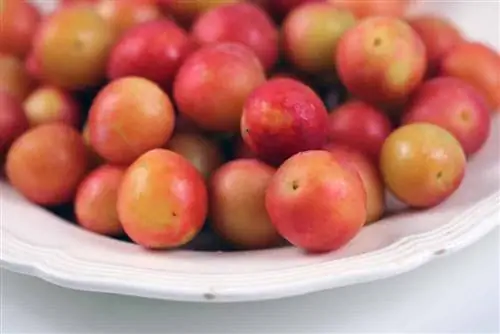- Author admin [email protected].
- Public 2023-12-17 03:39.
- Last modified 2025-01-24 12:45.
The mirabelle plum tree usually does not grow as a tree, but rather as a large, sprawling shrub. Its upright branches usually branch very strongly. Foliage and flowers develop at the same time. Although this plant is primarily grown for its versatile fruits, its abundant blooms in spring are spectacular. High season for the sweet and juicy fruits is between July and September. The fruit peel is, like the plum, shiny and leathery. The almond-like core inside the fruit can be easily removed when fully ripe.
Varieties
Among the numerous mirabelle plum varieties, there are self-fertile varieties and those that require a pollinator variety. However, the majority are self-fertile. When buying appropriate plants, you should give preference to varieties that are particularly hardy and have good resistance to the dreaded Sharka disease. The most widely grown and best-known variety is the Mirabelle de Nancy. But other varieties are in no way inferior to this one, at least in terms of taste.
Mirabelle by Nancy
Nancy Mirabelle is an old French variety and also the best known. It is self-fertile and at the same time a good pollen donor. In addition, it is very vigorous and requires sufficient space. The almost spherical, yellow and slightly reddish fruits on the sunny side are ready to harvest from mid to late August. They are moderately juicy, sweet and spicy in taste.
Metzer Mirabelle
This medium to strong growing small tree is also self-fruitful and very productive. The yellow fruits are aromatic, very sweet and juicy with a pleasant scent. They are ready to eat or harvest from July.
Miragrande
Miragrande is a relatively new, high-yielding and self-fertile variety. It is very vigorous and bears fruit from the second year onwards, with the full yield occurring around the fourth year. The juicy and aromatic fruits are comparatively large, yellow and, like almost all varieties, have reddish dots on the sunny side. The ripeness for consumption occurs between the end of August and mid-September.
Early Mirabelle Mirabelle from Bergthold
Bergthold is an old, self-fertile and early variety. It ripens in the 5th plum week, about 3 weeks earlier than the 'Nancy' variety. It has a certain tolerance to Sharka disease. The fruits are slightly smaller, golden yellow with a reddish sunny side and medium-firm, quickly softening flesh. They are sweet with a typical mirabelle plum aroma.
Bellamira
This variety is also self-fertile and very productive. In addition, it is very robust against Sharka and Monilia diseases. The fruits are large and golden yellow with firm, juicy and sweet-tasting flesh. The ripeness for consumption is between mid-August and mid-September.
Mirabelle 'Von Pillnitz'
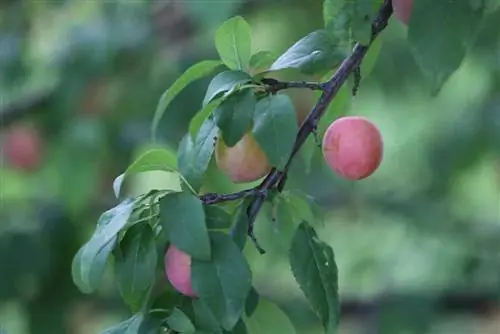
This strong-growing, upright and very high-yielding variety also has a high tolerance to Sharka disease. The yellow, very sweet and aromatic fruits are ready to eat or harvest between August and September. Thanks to its maximum height of 300 cm, it is also very suitable for smaller gardens.
Apricot Mirabelle 'Aprimira'
The apricot mirabelle has a tightly upright, almost columnar growth. Unlike most other varieties, 'Aprimira' requires a pollinator variety. The fruits are orange-yellow with reddish cheeks on the sunny side and firm flesh. Its taste is honey-sweet with a slight apricot aroma.
Plants
When planting, the first thing to consider is whether the plants are self-fertile or a variety that requires a pollinator. The latter requires correspondingly more space, so you should plan around 20 m² per plant. Planting distances of around five meters are recommended. Can be planted in both autumn and spring, depending on whether it is bare root or container plants.
- Bare-rooted plants preferably in the leaf-free period, plant from September
- They take a little longer to grow
- Container plants can be planted all year round
- Water the root ball thoroughly before planting
- This makes it easier for the plant to grow
- In the meantime, dig a planting pit
- It should be at least twice as deep and wide as the bale
- Then loosen the soil at the bottom of the planting hole
- Put some of the excavated earth on top
- For optimal support, the simultaneous insertion of a support post is recommended
- Support post should be inserted approx. 50 cm from the trunk
- It should reach below the crown
- Now insert the mirabelle plum tree
- The finishing point should be about a hand's breadth above the ground
- Mix excavated soil with well-rotted compost or manure
- Fill the planting hole with excavated soil
- After filling, tamp down soil and water abundantly
- Attach the support loosely to the trunk using coconut rope or something similar
Tip:
Even if you have a self-fertile variety and no additional plant is generally required, a second specimen can significantly increase the fruit yield.
Location
Mirabelle plums are one of the early bloomers of the year and love it warm and sunny. However, they can react sensitively to late frosts in spring. Accordingly, you should pay attention to a sunny to semi-shady location and, above all, protected from wind and weather. In order to develop their full aroma, mirabelle plums should be kept as sunny as possible.
Ideally, you should plant them near a wall, a house wall or in front of a high, evergreen hedge. When choosing the right location, you should definitely take into account the final height of the mirabelle plum tree and its sprawling crown. Depending on the variety, it can grow up to 600 cm in height and the crown can reach a diameter of up to 400 cm.
Tip:
Slow-growing varieties are best suited for smaller gardens. In addition, these plants are also offered as so-called columnar fruit, which, due to their growth habit, can also be kept very well in pots on terraces and balconies.
Floor
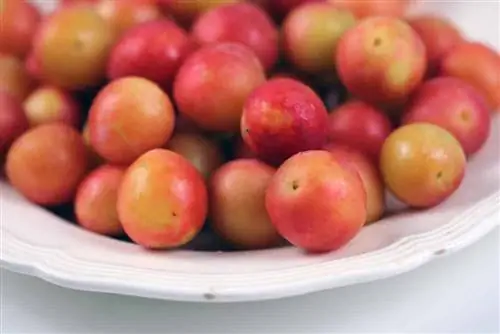
The mirabelle plum tree does not place any great demands on the properties of the soil. It should only be loose, permeable, humic, nutrient-rich and slightly moist. A pH value between 6 and 6.5 is optimal. If necessary, adding lime can be useful. The permeability of heavy or compacted soils can be improved by incorporating coarse sand. The only thing that should definitely be avoided is waterlogging.
Care
The flowers of the mirabelle plum tree appear between April and May and bathe the surrounding area in a sea of white flowers. The care required for this abundance of flowers and the resulting fruit yield is comparatively low. But this plant doesn't work without care either.
Pouring
- Water young mirabelle plum trees regularly and sufficiently in the year they are planted
- Also applies to persistent heat and dryness in summer
- Later these plants can take care of themselves
- Waterlogging should be avoided
- Application of a layer of mulch on the root area is recommended
- Can protect the soil from drying out too much
- Provides the plant with additional important nutrients
- It is best to apply a layer of mulch immediately after planting
- Should be renewed every year
Fertilize
In order to supply the mirabelle plum tree with sufficient nutrients, it is usually sufficient to add some compost once in spring and early summer or to fertilize it with home-made nettle or comfrey manure.
Cutting
Mirabelle trees are relatively vigorous. Without pruning, the crown would branch out heavily and at some point become so dense that hardly any sunlight can reach the inside of the crown, which the fruits need to ripen. Regular pruning is essential to keep the crown permeable. This can be dispensed with in the first two years. Later, depending on what you want to achieve with the respective cut, you talk about an educational cut, a thinning cut and a rejuvenating cut.
Educational Cut
A training pruning should promote an upright and even trunk (strong, middle main shoot) and horizontal leading branches evenly distributed around this trunk. The fruit-bearing shoots later form on these leading branches. The training pruning should be carried out on young trees, around the second year of growth. The main shoot should neither be cut nor injured during pruning measures. Only he althy and strong side shoots that are approximately at the same height should be chosen as leading branches. All shoots growing below the main branches are removed at the base.
Blending cut

The thinning cut refers to the crown and should be done annually in early spring. It aims to ensure that sufficient light and air can reach the inside of the crown again.
- Remove all inward-growing, dead and crossing shoots
- Cut out downward growing shoots and so-called water shoots
- Water shoots usually formed inside the crown from sleeping buds
- They are upright growing, soft shoots
- Mirabelle tree reacts to thinning cuts with increased formation of new shoots
- Not all of these shoots are suitable as fruit shoots
- Limit increased sprouting next year with another thinning cut
Rejuvenation cut
Older trees that have been neglected for a long time and practically left to their own devices can be corrected with a rejuvenation cut and stimulated to grow he althy again. Over the years, a tangled mess of branches and twigs has often formed, which this cut should reduce to a he althy level.
First you look at the tree to decide which combinations of branches, together with the upper part of the trunk, come closest to the ideal image of a light-flooded crown with evenly distributed leading branches. Then you can remove all branches that disturb this ideal image. The intermediate result should be checked again and again and it is better to use the saw less than once too much. To prevent the branches from tearing out, you first saw a little further away from the trunk until finally the branch stump is sawed off close to the trunk.
Wintering
In the first few years, young mirabelle plum trees can be wrapped with fleece in winter and thus protected from severe frosts. Frost hardiness increases with age. Older specimens are usually hardy down to minus 30 degrees. Even in winter, the soil should not dry out completely. It is therefore advisable, especially in dry winters, to occasionally water moderately, but only on frost-free days.
Propagate
Sowing
- Only use seeds from fully ripe fruits for sowing
- Slightly file the seeds before sowing
- If necessary, soak in room temperature water for 24 hours
- This is supposed to make germination easier
- Then put the seeds in small pots with good garden soil
- It's best to always sow several seeds, not everyone is able to germinate
- Moisten the soil and place pots in a warm place
With a bit of luck, the first seeds will germinate after a few weeks. If the seedlings are large and strong enough, you select the strongest ones and initially cultivate them in the pot and plant them outside the next spring. Plants grown from seeds bear fruit for the first time after 6 or 7 years at the earliest.
Root Boom
For propagation via root shoots, you should only use non-rooted, i.e. ungrafted, plants. In the case of grafted plants, only the rootstock used for grafting would multiply. To get suitable root shoots, expose the root area of a well-developed shoot, which should have some leaves as well as roots. Use a sharp tool to separate this from the main root.
Then you first put it in a rooting powder and then in small pots with potting soil or directly in the ground in the garden. The soil should always be kept slightly moist for the next few weeks.
Diseases
Sharka disease
Sharka disease caused by the Sharka virus is often difficult to recognize as such. In summer, the leaves appear washed out, cloud-like brightening, the fruits appear scarred, with grooves and pock-like deformations. The flesh is rubbery and reddish in color in places. Control is usually not possible; affected plants must be completely removed and disposed of. As a preventive measure, you should pay attention to varieties that are as resistant as possible, which can also be infected but do not show these symptoms.
Shotgun disease
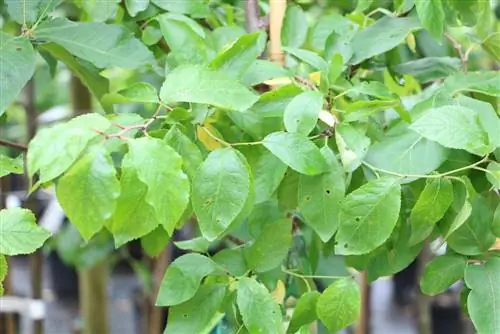
Small reddish-brown spots on the leaves that later die and fall out of the leaf tissue can indicate shotgun disease. The cause is a fungus that occurs particularly in damp weather in spring. The disease is usually more pronounced in the lower parts of the plants. Special fungicide preparations from specialist retailers are suitable for combating it. You can take preventative action by, for example, thinning out the mirabelle plum tree regularly, ensuring that the location is well ventilated and protected from constant rain, and preferring resistant varieties.
Monilia Lace Drought
Monilia peak drought occurs primarily on stone fruits and can initially be recognized by the one-year-old wood of young shoots. Whole flower clusters wilt immediately after opening. As a result, the leaves fade, hang limply and wither. To combat this, as soon as an infestation is discovered, diseased shoots should be cut off deep into the he althy wood and all fallen fruits and leaves should be picked up and disposed of with household waste.
Pests
Frost tensioner
The larvae of the frost moth (green caterpillars) cause eating spots on young leaves and shoot tips in spring, whereby a severe infestation can go as far as leaf damage. To protect against these pests, the trees can be protected with glue rings in autumn. If these are dried out or dirty, they should be replaced. The small caterpillars can be controlled with approved pesticides.
Pouched gall mite
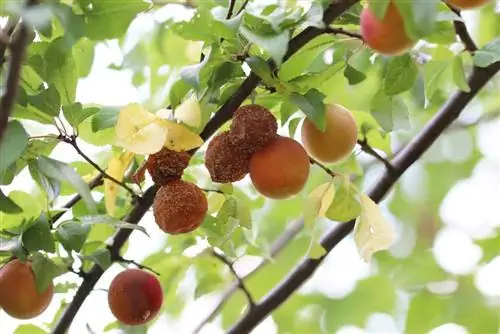
If greenish growths, so-called galls, appear on the undersides of the leaves and especially the edges of the leaves in spring, which turn reddish in the summer, it may be an infestation with the marsupial gall mite. Control with pesticides is only necessary if severe infestation occurs repeatedly over several years.
Aphids
Several species of aphids can occur on mirabelle plums. An infestation is usually only discovered when the leaves curl or curl up and the damage has already occurred. Older plants usually survive an aphid infestation without any problems, so control is not absolutely necessary. Otherwise, preparations with potassium soap or rapeseed oil can be used, although oil-containing products should not be used during the flowering period.
Conclusion
The mirabelle plum tree is a must for many hobby gardeners. This is mainly due to its delicious and versatile fruits but also the beautiful flowers that usher in spring in April/May. Depending on the variety, mirabelle plums take on their intense yellow or yellow-red color between August and September and can be harvested. To ensure a consistently high fruit yield, the mirabelle plum tree should be pruned regularly. Otherwise it is very easy to care for and undemanding.


